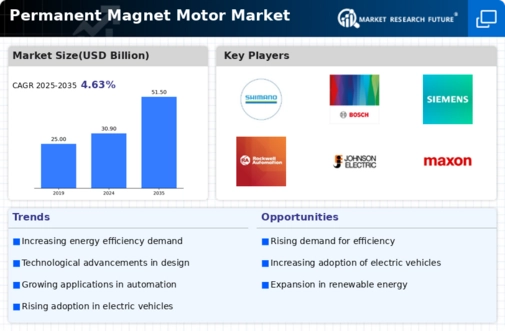Top Industry Leaders in the Permanent Magnet Motor Market

*Disclaimer: List of key companies in no particular order
The realm of permanent magnet motors (PMMs) has transformed into a bustling hub propelled by the skyrocketing demand for electric vehicles (EVs), industrial automation, and renewable energy solutions. It comes as no surprise that both established industry leaders and ambitious newcomers are vigorously vying for a foothold in this immensely profitable domain. Let's delve into the intricate strategies, evolving trends, and cutthroat competition shaping the future landscape of PMMs.
Key Player Strategies: Innovation and Diversification An array of global titans such as ABB, Siemens, Nidec, Bosch, and other stalwarts have long held sway, capitalizing on their robust R&D capabilities and established distribution networks. Their focus revolves around optimizing motor efficiency, curbing rare-earth dependency, and tailoring application-specific solutions for EVs, robotics, and wind turbines. Siemens' Formel D electric motor boasts unparalleled power density, while ABB's high-speed PMMs cater to demanding industrial applications.
Asian powerhouses like Toshiba, Denso, and WEG have been making significant strides, leveraging their cost-competitive advantage and proximity to burgeoning EV markets like China. Their growth is fuelled by strategic partnerships and acquisitions, enabling them to tap into novel technologies and regional expertise. WEG's recent acquisition of Austrian electric motor manufacturer Elin Motoren has significantly bolstered its footprint in Europe.
Emerging Players: Niche Expertise and Sustainability Beyond the established players, a wave of pioneering startups is charting new territory. Companies like Hyperion Motors and Maxwell Technologies are at the forefront, introducing high-temperature superconducting PMMs promising unparalleled efficiency and compactness. These innovations hold promise for aerospace and high-performance industrial machinery applications.
Sustainability has emerged as a pivotal differentiator for emerging players. Verde Electric's focus on recycling rare-earth magnets from used electronics is a testament to the environmental conscientiousness that's gaining momentum, as responsible sourcing becomes a critical market driver.
Market Share Analysis: A Multifaceted Lens Unraveling the market share in the PMM landscape demands a nuanced approach. While conventional metrics like revenue and unit shipments hold significance, factors such as patent portfolios, technological advancements, and regional dominance offer a more holistic perspective.
Companies like Nidec and Johnson Electric boast impressive shipment volumes, particularly in the consumer electronics segment. However, European players like Bosch and Siemens lead in high-value industrial applications, commanding premium prices for their specialized solutions.
Emerging trends such as rare-earth-free PMMs and integrated motor-drive systems possess immense potential to disrupt market share dynamics. Companies heavily investing in these domains and securing crucial patents stand to gain a substantial competitive edge.
New and Emerging Trends: Shaping the PMM Landscape The PMM market is a realm in constant flux, propelled by technological breakthroughs and evolving market needs. Here are some key trends to monitor:
-
Rare-earth Alternatives: Seeking substitutes for rare-earth magnets like neodymium and dysprosium is pivotal for long-term sustainability and cost reduction. Research into lanthanum-based magnets and ferrite magnets is gaining momentum. -
Software-Defined Motors: Integrating intelligence and control algorithms into PMMs unlocks new efficiency levels, precision, and predictive maintenance capabilities. This trend is particularly relevant for industrial automation and EV applications. -
3D Printing of PMMs: Additive manufacturing offers opportunities to design intricate motor geometries and customize motors for specific applications. This could result in lighter, more efficient, and application-specific PMMs.
The Competitive Scenario: Collaboration and Rivalry The PMM market is characterized by both intense competition and strategic collaboration. While companies vie for market dominance, they also recognize the value of partnerships to overcome technical barriers and access new markets.
Consortiums like the DRIVE Automotive alliance bring together automakers and PMM manufacturers to expedite EV development. Similarly, research collaborations between universities and industry players foster innovation and knowledge exchange.
Looking ahead, the PMM market promises to be a dynamic arena where established players, disruptive startups, and strategic partnerships will navigate a complex web of competition and collaboration. Success will hinge on innovation, adaptability, and a commitment to sustainable practices.
The permanent magnet motor market is a riveting nexus of innovation, competition, and continually evolving trends. Understanding the strategies of key players, market share dynamics, and emerging trends is paramount to navigate this dynamic landscape. As the world accelerates towards a more electrified and sustainable future, PMMs will undeniably play a pivotal role in powering our progress.
Industry Developments and Latest Updates:
Allied Motion (US):
- Announced the launch of a new line of high-efficiency brushless DC motors for industrial automation applications.
Johnson Electric (Hong Kong):
- Showcased its latest permanent magnet motor technology at the Electronica trade show in Munich, Germany.
Emerson (US):
- Received a patent for a new design of high-efficiency permanent magnet motors for industrial applications.
WEG (Brazil):
- Launched a new line of energy-efficient permanent magnet motors for water pumps and industrial fans.
Toshiba Corporation (Japan):
- Signed a joint venture agreement with a Chinese company to produce permanent magnet motors for electric vehicles.









